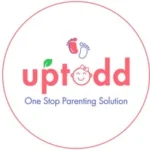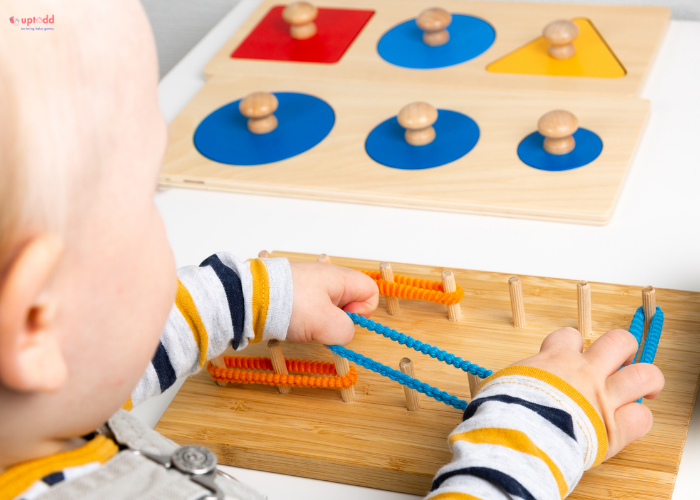
Montessori Toys – How to choose them for your Toddler?
Topic
Montessori Toys – How to choose them for your Toddler?
May start as early as
12 Months
─────────
Related Skills
Introduction to Montessori toys
If you’re a parent, you’ve likely come across the term “Montessori” and wondered why it’s everywhere in conversations about child learning and toys. From schools to toy stores, Montessori has become a gold standard in child development.
But what makes Montessori toys different from other toys? And how do you choose the right ones for your toddler’s age and developmental stage?
In this detailed guide, our experts at UpTodd break down everything you need to know about Montessori learning, its philosophy, and how the right toys can make playtime purposeful and enriching for your child.
Then let’s find out.
What We Will Cover in This Blog !
What is the Montessori Method and how it began
How Montessori toys help toddlers learn through play
How to identify authentic Montessori toys
Five classic Montessori toys every parent should own
Expert insights on how Montessori learning supports independence
Conslusion (Final words) on the Blog
Common FAQs about Montessori and baby toys
What is the Montessori Method ?
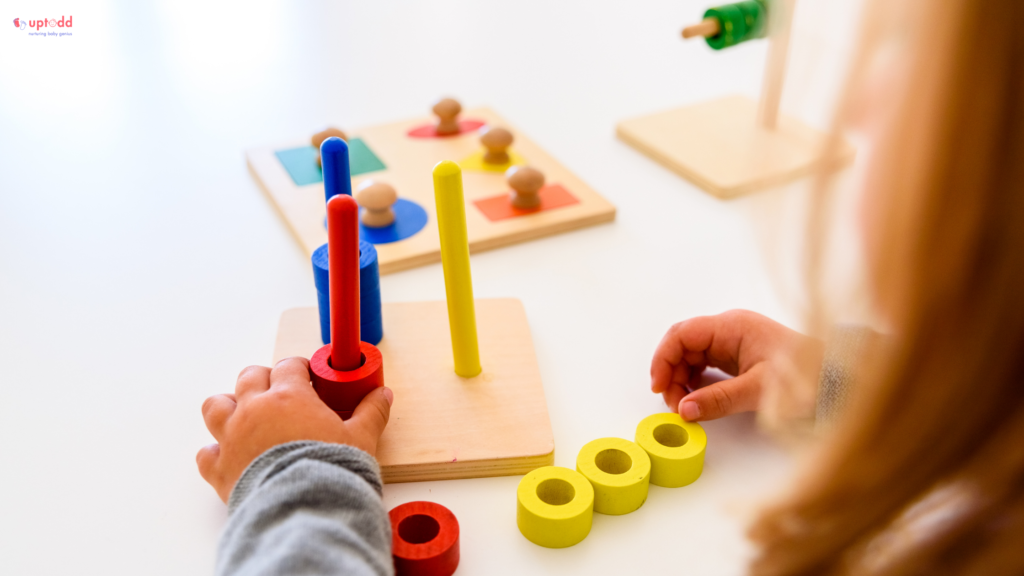
The Montessori Method, is developed by Italian physician Maria Montessori in the early 1900s, has an intriguing origin. While working in a hospital, she discovered that toddlers learned more effectively when they were active and engaged with the world around them.
As a result, she began experimenting with ways to make learning easier and more interesting. Eventually, she introduced the concept of separating the classroom into different areas, each serving a specific purpose. For example, one area might contain small objects for building, another for playing games, and yet another for reading books.
Furthermore, Montessori observed that toddlers preferred spending their time in open spaces rather than being confined to a classroom. They felt excited to explore and play, with the comfort of knowing they could return to the teachers whenever they needed help. Over time, Montessori refined her ideas, and today, many preschools and elementary schools use her approach.
Additionally, Montessori schools follow principles of child development, encouraging toddlers to explore their surroundings. These schools provide a safe and stimulating environment, helping toddlers build self-confidence and independence. Using Montessori resources, kids can engage in various activities with minimal adult intervention.
Parenting truly is an incredible journey! One day, you’re singing lullabies to your new born, and before you know it, they’re off to school. In this adventure, the moments spent with toddlers, especially during playtime, become some of the most cherished memories.
Reference From- Exploring Montessori toys and games
How Montessori toys helps in learning through play
The Montessori Method emphasizes that toddlers learn best through engaging, fun activities. Also Toddlers using this method often show improved happiness, health, and behavior. They also excel academically and interact more positively with others.
Playing games offers one of the most effective ways to learn something new. Active learning, through play, benefits both toddlers and adults. Games help us grasp how things work together and provide insights into ourselves.
Here are a few key ways Montessori toys help with learning:
- Hands-on exploration: Toys such as blocks and puzzles teach fine motor skills and problem-solving.
- Improved concentration: Montessori toys require active participation, helping toddlers build patience and focus.
- Encouragement of creativity: Open-ended toys allow children to imagine and create new things.
- Practical learning: Toys that mimic daily tasks teach independence and coordination.
- Self-correction: Toys that provide feedback, such as puzzles that fit only one way, allow toddlers to learn from their mistakes.
You can explore more in our master guide: Baby Toys – Best Picks
How to Identify a True Montessori Toy
Nowadays, the word “Montessori Toy” could be used as a marketing gimmick. Every such claim may not be true. We have mentioned some ways to verify these claims to save your money and time and protect against unsafe toys.
Montessori toys are made for Toddlers ages 2 to 6 years old. The toys are designed to be used by Toddlers who are learning how to read, write or count.
They are usually colorful, educational, and easy to use. Most Montessori toys are made from wood, plastic, metal, or other materials that are safe for Toddlers. Most Montessori toys do not require batteries. They come in different shapes and sizes, such as blocks, puzzles, and dolls.
Not every toy labeled “Montessori” follows the actual philosophy. Many modern toys use the term as a marketing tactic. Here are key ways to identify genuine Montessori toys.
1. Focus on one concept at a time
The Montessori system promotes that Toddlers acquire skills one at a time. A toy with too many elements might confuse the child and bouncing from one activity to the next doesn’t help your child concentrate.
2. Encourages active play
Toys that require kids to play actively using their hands, legs, and other sensory skills can be termed, Montessori. A toy with lights and noises that moves on its own, makes the child a passive observer which does not aid their fine motor, gross motor, and cognitive skills to develop. Active play with other kids also helps develop emotional skills.
3. Made from natural materials
Using real materials helps the child understand the texture, smell, taste, and consistency – something that plastic can never provide. Giving them a real scissor to cut paper(while monitoring), instead of a plastic scissor, gives rich sensory learning for the child. Choose high-quality toys using real wood and no sharp edges.
4. Simple design
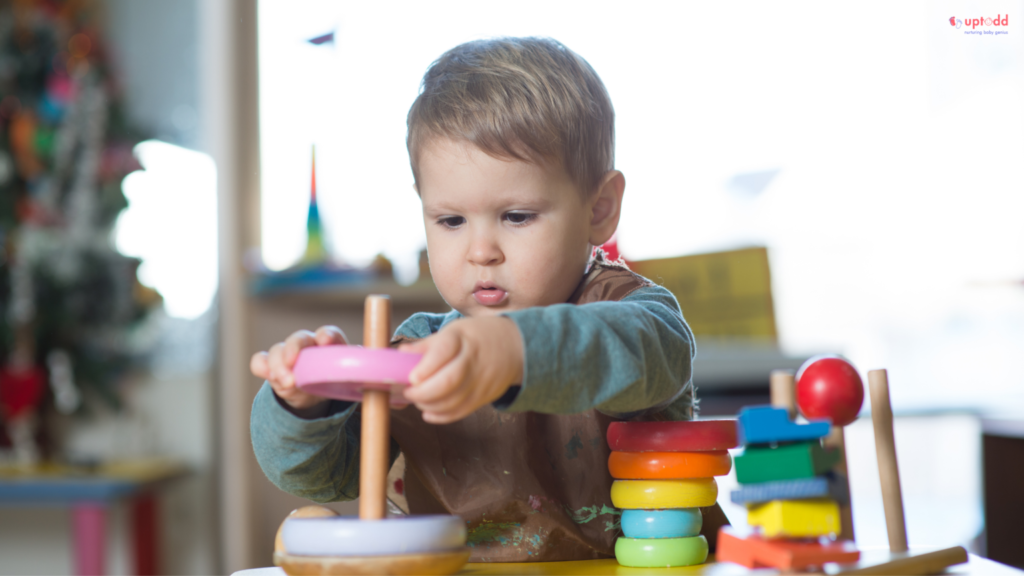
The Montessori idea supports simple toys. Like, an object permanence box just consists of a wooden box with slots on top into which the child can drop different kinds of shapes, while it might look easy for us, it supports the developmental stage that the child is going through.
5. Open-ended play
A toy that offers multiple ways to play boosts a child’s creativity and imagination. Open-ended toys allow for easy, continuous exploration, encouraging children to engage deeply. Montessori open-ended toys provide numerous benefits by promoting self-exploration while supporting mental and physical growth.
6. Self-correcting structure
Toys that are designed in a way to give feedback to the child whether the activity is done or not, help the child to focus on the right path with minimal adult intervention.
Reference from- Montessori education
Five Classic Montessori Toys You Should Have at Home
There is a wide range of Montessori Open-ended toys used in elementary schools which you can explore for home schooling. However, in the early years a child spends most of their time at home. Here are a few classic Montessori toys that you must have in your home to supplement the learning process.
1. Rattles & teethers
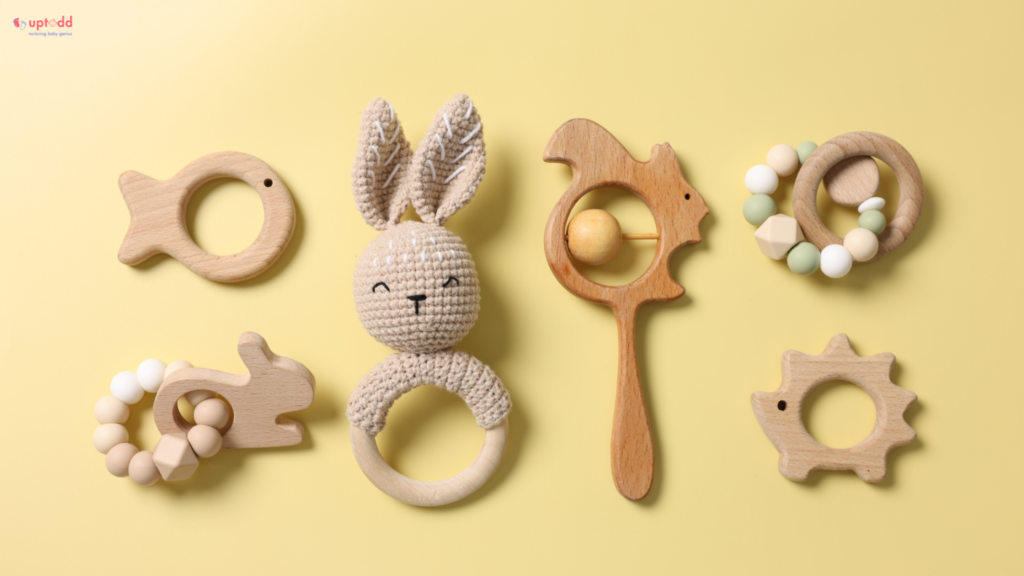
Baby rattle toys serve as one of the first open-ended toys, designed specifically for infants. These playful rattles offer more than just entertainment; they play a key role in a baby’s healthy development.
Babies love exploring the toys we give them. When they find a rattle, they hold it tightly, observe it, shake it, and in doing so, develop their fine motor skills. Their grasp reflex encourages muscle growth and pre-writing abilities in newborns.
They carefully listen to the sound and feel the texture, which sharpens their sensory skills. Since babies often chew on toys while teething, it’s essential to choose safe rattles and teethers for them.
2. Play silks
As your child enters the toddler phase, eighteen months commemorates the age of independence and discovery. That is why baby play activities, such as play silks that promote motor control and coordination, help in improving real-life skills, essential for the early years. Play skills can be used for outdoor activities too as they promote pretend play which enables practical skills in the later stage of life. Here are a few ideas to engage your child with play silks and make the most out of this amazing sensory toy.
3. Shape Sorter

Sorting objects by size, shape, or color, is a developmental milestone for cognition (learning, thinking, problem-solving). By age 2, Toddlers begin to understand the concept of sorting. By age 4, a child will be able to identify some colors and sort. Research has also suggested that learning to sort is one of the many skills that can contribute to stronger math skills later on. The shape sorter is one of the perfect toddler toys that promote activities for toddlers with parents and caregivers.
4. Building Blocks
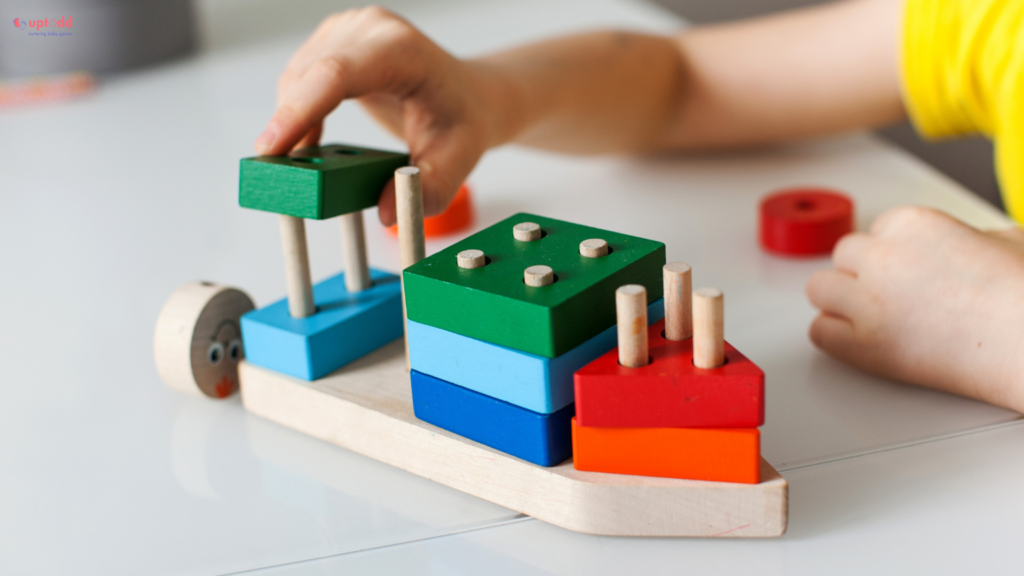
As Toddlers progress through the various stages of block play, they develop their fine motor and gross motor skills. Some are simple planks made of wood, while others are fancy, like interlocking bricks of plastic. But whatever form they take, blocks can function as powerful learning tools. Studies suggest that toy blocks can help Toddlers, especially school-aged Toddlers develop motor skills and hand-eye coordination.
5. Life skill toys
Toddlers benefit the most from real-life experiences over ‘pretend’ toys. You can enable these daily life experiences with child-sized Montessori materials such as rolling pins, wooden knives, or even a Cleaning Kit for Kids which helps them learn the everyday skills of household activities. This not only encourages building social skills but also the independence and hands-on learning of everyday activity in a job well done.
Reference from- Play-Based Learning: How Montessori Toys Can Help Your Child Learn and Grow
Expert View: Dr. Paul, Child Development Specialist at UpTodd
According to Dr. Paul, “Montessori toys are designed to help children take charge of their learning. They are not about entertainment; they are about building confidence, coordination, and curiosity. When a child plays with these toys, they are developing patience, focus, and resilience — skills that will benefit them for life.”
Conclusion
The Montessori method is more than a teaching style; it is a way of nurturing curiosity and independence in children. Montessori toys, with their natural materials and open-ended designs, help toddlers explore, imagine, and learn through experience.
By choosing authentic Montessori toys, parents can provide a balanced play environment that promotes creativity, coordination, and self-confidence. Remember, children learn best when playtime is simple, safe, and meaningful.
For parents looking to bring Montessori-inspired learning home, start small. Choose a few well-designed toys that encourage focus and exploration rather than filling the playroom with dozens of distractions.
Visit UpTodd to discover more expert-recommended toys and child development resources designed by specialists from IITs, AIIMS, MIT (USA), and Stanford.
FAQS
Q1. What makes a toy Montessori?
A Montessori toy is one that promotes independent, hands-on learning. It is made of natural materials, simple in design, and focuses on developing a single skill at a time.
Q2. How can I make baby toys at home?
You can create simple Montessori-inspired toys using household materials such as wooden spoons, cardboard boxes, and cloth bags. Ensure they are non-toxic, smooth-edged, and safe for your baby to explore.
Q3. How can I clean baby toys that cannot be washed?
Wipe them with a damp cloth using mild, baby-safe soap or vinegar. Avoid soaking wooden toys; instead, gently clean and let them air dry.
Q4. How can I disinfect baby toys safely?
Use a 1:1 vinegar-water solution or baby-safe disinfectant wipes. Avoid harsh chemicals or alcohol-based cleaners, as they may damage the toy or irritate the baby’s skin.
Q5. How can I clean baby toys that have batteries?
Remove the batteries before cleaning. Wipe the exterior gently with a damp cloth and avoid water near electrical parts. Let the toy dry completely before inserting batteries again.
Q6. Where can I buy Montessori or baby toys?
Buy only from trusted brands or certified Montessori suppliers that use safe, natural materials. UpTodd recommends verified stores with clear safety certifications and eco-friendly practices.
Q7. Can I wash baby toys in a washing machine?
Soft fabric toys can be machine-washed on a gentle cycle using mild detergent. Always air dry them completely before giving them to your child.
Explore More
Research & Resources
- https://snooplay.in/blogs/news/exploring-montessori-toys-and-games-benefits-of-montessori-learning-for-children
- https://www.nature.com/articles/s41539-017-0012-7
- https://gleenaturaltoys.com/products/bricky-blocks
- https://erenjoy.com/blogs/montessori-toys/play-based-learning-how-montessori-toys-can-help-your-child-learn-and-grow?srsltid=AfmBOoo8W7PtinwXYHx6JSI1tbN-B6FqMiZq8Uuf7iEW4IhwRL-rpGRO





